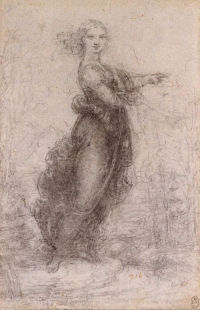
- Enlarge
- Zoom & explore
- The Royal Collection © 2005, Her Majesty Queen Elizabeth II
Young Woman (so-called pointing Lady) c1516
The visionary quality of this atmospheric drawing has given rise to the identification of this figure as Matelda, who suddenly appears to Dante and becomes his guide until the appearance of his beloved Beatrice at the end of the Purgatorio, canto xxviii.
Matelda appears as standing, and points out to him the river of Lethe and the rustling grove. While the drawing probably should not be interpreted as a literal illustration, its profoundly expressive quality can certainly be described as poetic. Leonardo’s writings contain many echoes of Dante, to whom he looked both for literary imagination and scientific information. However, it is notable that the figure’s costume is highly reminiscent of Botticelli’s illustrations for the Divine Comedy, done for Lorenzo di Pier Francesco de’ Medici, with whom Leonardo was in contact during 1502 and 1503.
- Medium Black chalk
- Size 21 x 13.5 cm
- Location The Royal Collection
